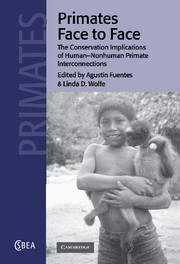Book contents
- Frontmatter
- Contents
- List of contributors
- Foreword
- Acknowledgements
- Introduction
- Part 1 Science and nonhuman primates
- Part 2 Cultural views of nonhuman primates
- 4 Monkey as food, monkey as child: Guajá symbolic cannibalism
- 5 Ethnoecology of monkeys among the Barí of Venezuela: perception, use and conservation
- 6 Primates in Matsigenka subsistence and world view
- 7 Monkey King in China: basis for a conservation policy?
- 8 Reflections on the concept of nature and gorillas in Rwanda: implications for conservation
- Part 3 Conservation of nonhuman primates
- Part 4 Government actions, local economies and nonhuman primates
- Index
6 - Primates in Matsigenka subsistence and world view
Published online by Cambridge University Press: 20 October 2009
- Frontmatter
- Contents
- List of contributors
- Foreword
- Acknowledgements
- Introduction
- Part 1 Science and nonhuman primates
- Part 2 Cultural views of nonhuman primates
- 4 Monkey as food, monkey as child: Guajá symbolic cannibalism
- 5 Ethnoecology of monkeys among the Barí of Venezuela: perception, use and conservation
- 6 Primates in Matsigenka subsistence and world view
- 7 Monkey King in China: basis for a conservation policy?
- 8 Reflections on the concept of nature and gorillas in Rwanda: implications for conservation
- Part 3 Conservation of nonhuman primates
- Part 4 Government actions, local economies and nonhuman primates
- Index
Summary
Introduction
Much ado has been made in recent years about whether indigenous people are conservationists, noble savages who act as stewards of nature, or whether they are efficient predators who maximize their exploitation of resources with the available technology, and thus represent a growing threat to biodiversity conservation in endangered ecosystems. A summary of arguments on both sides can be found in the tête-à-tête between Alcorn (1993) and Redford and Stearman (1993) in Conservation Biology. I will set aside a more thorough discussion of the complex debate for now, only to note that, in its essence, the polemic has to do with different notions of what constitutes Nature, and whether or not culture, or certain kinds of cultures, are part of the natural world.
The clash between alternative conceptions of nature was poignantly illustrated in 1993 during an interaction between a Matsigenka hunter and a Peruvian bureaucrat. The two met at a workshop held in Manu National Park during which, for the first time since the creation of the park in 1973, representatives of the Peruvian government, the park administration, and the conservation community explained to Matsigenka inhabitants what a national park was, and why one had been created in Manu twenty years before.
- Type
- Chapter
- Information
- Primates Face to FaceThe Conservation Implications of Human-nonhuman Primate Interconnections, pp. 101 - 136Publisher: Cambridge University PressPrint publication year: 2002
- 78
- Cited by

